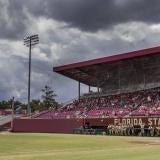Download the CBS Sports App today and get the latest scores, news and alerts from Major League Baseball, plus get daily MLB picks from SportsLine!
The United States claimed their first World Baseball championship on Wednesday night. They bested Puerto Rico in the very one-sided title game, thanks largely to WBC MVP Marcus Stroman. He took a no-hitter into the seventh inning.
Even without their very best players, like Mike Trout and Clayton Kershaw, USA fielded a roster loaded with All-Stars. The country’s talent pool is crazy deep. USA’s inability to win any of the previous WBCs had more to do with a lack of execution than a lack of great players. They were always good enough to win.
Exactly how good is this USA roster? Good enough to win the WBC obviously, but how would they fair during the grind of a 162-game major league season? That’s what we’re going to attempt to figure out here. Attempt is the key word. We’ve got to make some assumptions and take some leaps of faith. Besides, this is all for fun. Let’s get to it.
Simple Method: Run differential

USA really helped their WBC run differential with Wednesday night’s 8-0 win the title game. They scored 41 runs and allowed 21 runs in their eight games, which works out to 5.13 runs scored per game and 2.63 runs allowed per game. For reference, the Red Sox led baseball with an average of 5.42 runs scored per game in 2016. The Cubs led with 3.43 runs allowed per game. Run prevention was USA’s greatest strength at the WBC.
Assuming -- again, we have to make some assumptions here, more than a few of which will be dubious -- USA averages 5.13 runs per game during the 162-game season, they’d score 831 runs. Based on their runs allowed average, they’d allow 426 runs in 162 games. That’s a run differential of +405, which, believe it or not, would not be an MLB record. The juggernaut 1939 Yankees had a +411 run differential.
Based on the run differential, USA would be expected to have a .792 winning percentage, which works out to a 128-34 record across 162 games. Yes, that would be a record. Here are the best single seasons in MLB history:
- 1906 Chicago Cubs (116-36, .763)
- 1909 Pittsburgh Pirates (110-42, .724)
- 1954 Cleveland Indians (111-43, .721)
- 1969 Baltimore Orioles (109-53, .719)
- 2001 Seattle Mariners (116-46, .716)
The 1927 Yankees (.714) and the 1998 Yankees (.704) are the only other teams in baseball history to eclipse a .700 winning percentage in a single-season.
Needless to say, our simple method is exactly that: simple. We’re taking eight games worth of data and extrapolating it out across a 162-game season. We wouldn’t expect Brandon Crawford and Eric Hosmer to hit .385 all season like they did in the WBC, would we? Of course not. Same way we wouldn’t expect Nolan Arenado to hit .212 all season. Weird things happen in small sample sizes, and eight games is a very small sample size.
Let’s move on to a more sensible method.
Advanced Method: Projected WAR

We know USA’s roster and we have all sorts of projection systems estimating each player’s current talent level for the 2017 season. That can help us. Here are the projected WAR numbers for USA’s roster:
ZiPS | Steamer | PECOTA | Average | |
Position Players | 43.9 | 44.4 | 52.0 | 46.8 |
Pitchers | 22.2 | 20.8 | 15.5 | 19.5 |
Total | 66.1 | 65.2 | 67.5 | 66.3 |
A team of replacement level players would be expected to win about 48 games in a given season because even a team of Quad-A caliber players is going to manage to win a few games. Add our average position player WAR to our average pitcher WAR to the baseline 48 wins and you get 114.3 wins. (That’s 49.8 + 19.5 + 48 = 114.3, just to be clear.) Round it off to 114-48 and you get a win total that is certainly high, but not unprecedented in MLB history.
But wait! We have to consider playing time, right? USA’s roster included everyday position players. Those guys are going to go back to their teams and play everyday this season. There are only nine starting lineup spots, however. Daniel Murphy and Paul Goldschmidt were glued to the bench for USA, so we can’t pencil them in for 500-something plate appearances with USA like the projections expect.
We should make an adjustment for playing time, and to do that, we’ll use each player’s at-bat total during the WBC. I’d rather use plate appearances, but the WBC stats site lists at-bats only, so at-bats it is. Andrew McCutchen had 21 of USA’s 278 total at-bats in the WBC, or 7.6%. We will then count McCutchen’s projected WAR as only 7.6% of USA’s projected WAR. It’s a weighted average, basically. Here are the new numbers:
- Adjusted position player projected WAR: 19.9
- Pitcher projected WAR: 19.5
- Total projected WAR: 39.4
We don’t have to adjust pitcher projected WAR because USA had five starters (Stroman, Chris Archer, Drew Smyly, Danny Duffy, Tanner Roark) and that’s how many they’d use during the season. The rest of the pitching staff was relievers.
After adjusting the position player projected WAR for playing time, we get USA at 87-75 (19.9 + 19.5 + 48 = 87.4 wins). That sounds low and it almost certainly is -- projection systems tend to be conservative -- but it’s a function of Jim Leyland’s imperfect lineups. Goldschmidt is a much better player than Hosmer, yet Hosmer started at first base, so Goldschmidt is wasting away on the bench. Jonathan Lucroy is very good, but he’s not Buster Posey, yet they split playing time at the WBC. All the playing time imperfections drag down this roster’s potential.
Depending on the method, USA is either a juggernaut (128-34 per run differential) or a good team that would contend for a postseason spot (87-75 per adjusted projected WAR). I lean towards the latter myself given our playing time assumptions. USA’s starters had a 1.93 ERA during the WBC, and that’s just not going to happen across a 162-game season. Team USA was plenty good enough to win the WBC, which was essentially a short series. The long marathon of the season is another matter.






















